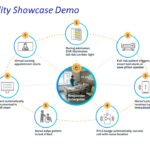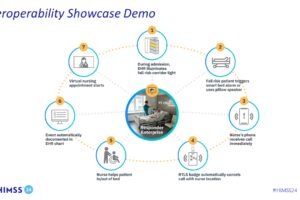It seems as though everyone is talking about digital transformation as of late. Talking about the different ways and areas that it can be helpful in the world of healthcare. All of that talk is well and dandy, but actually applying digital transformation to your organization is an entire different thing. It takes time to integrate, it can disrupt things, and it can take a while to adjust to. So while we all want the benefits of digital transformation, actually putting in the work to get it done can be intimidating.
We reached out to our Healthcare IT Today community to get their insights on the best way to integrate digital transformations into your organization. Check out what they have to say to see if it can help you!
Stephen Cavey, Co-Founder, Chief Evangelist at Ground Labs
Organizations may find that small-scale digital transformation (DX) initiatives are a more cost-effective and rational way to digitize a company’s processes and operations. Incremental DX change can be triumphant, even if your business has the capability and technological resources to do a complete overhaul. Deploying DX internally should be done strategically, thoughtfully, and in places where it will help employees become more productive.
Finding ways to give employees time back in their day encourages and promotes a culture of innovation and allows them to focus on areas that they are more passionate about, which in turn, may improve overall worker performance and job sentiment. Although there still may be some pushback, DX on a micro-scale gives employees time to adjust and fully comprehend how they can work hand-in-hand with newly digitalized systems.
Michael Armstrong, Chief Technology Officer at Authenticx
Digital transformation in itself is a bit of a buzzword. There’s so much we can do with technology now, and the act of using computers or new gadgets can no longer be considered digital transformation. In healthcare especially, the transformation is really about building the culture, business processes and mindsets needed to leverage the new technology in a way that truly impacts and benefits patients. The intersection of people and technology is what matters when implementing digital tools.
Dr. Kikelomo (Dayo) Belizaire, MD, MPH, Chief Medical Officer at Pegasystems
As Chief Medical Officer at Pegasystems, I have seen firsthand how revolutionary technology can change lives by allowing users and patients to work smarter, streamline operations, unify powerful experiences and adapt instantly. However, it must be adopted uniformly. Healthcare cannot be fully transformed unless we collectively embrace the idea of disruptive change and leverage innovative technology that is outcome-driven, not product-driven.
Derek Streat, Chief Executive Officer at DexCare
In order to ensure sustainability in a time of intense competition, evolving consumer expectations, and limited resources, health systems must commit to digital transformation. This means not only optimizing your digital front door but delivering seamless virtual or hybrid care experiences from start to finish, leveraging tools such as artificial intelligence, predictive modeling, and other technology to enable easy care discovery, best-fit experiences, and optimal outcomes.
Neel Butala, MD, Chief Medical Officer at HiLabs
The digital transformation of healthcare has been underway for decades in the form of electronic medical and administrative records, but it is now accelerating with the inclusion of patient/user-generated data. However, few healthcare organizations have leveraged digital transformation to its full potential. This is limited in large part by the large quantities of dirty data. For healthcare to get to this desired state, it will require a system to clean, systematize, and make sense of this data.
Ben Denkers, Chief Innovation Officer at CynergisTek
Digital transformation has expanded healthcare’s relationship with consumers in a mutually beneficial way. But with this technology adoption comes added security and privacy challenges with new attack surfaces that malicious actors can exploit. Organizations must know how data is classified, where it’s stored, who has access, and what safeguards are in place to ensure its security. Managing evolving threats isn’t static; it requires a vigilant, continuous risk management and monitoring program.
Krishna Kurapati, Founder and CEO at QliqSOFT
Many healthcare organizations have figured out how to overcome roadblocks to establish digital transformation as a sustainable IT infrastructure component. The four takeaways that I’ve learned while working with these committed game changers are: Maintain a checklist at the enterprise level, pledge cross-departmental coordination, start small, and fail fast and do it often, meaning be fearless experimenting with new patient engagement workflows.
Rahul Sharma, CEO at HSBlox
According to Harvard Business Review (HBR), over 70% of healthcare data is un-structured and exists in the form of charts/notes, images, freeform text, audio/video, wearables and in proprietary formats. A key to implementing digital transformation is data digitization and amalgamation of that data with structured and external data sets so that a 360 degree view of the patient can be achieved to provide actionable insights to Payers/Providers and the Patients. Artificial intelligence technologies coupled with Machine Learning algorithms in a robust data engineering framework that enables to/from integration between systems with this digitized data are needed in order to make this a reality.
Payers, Providers, Patients and other healthcare industry stakeholders benefit from moving to a fully digitalized offline-to-online patient journey, opening new opportunities in the R&D of medicines and delivery of healthcare services, while resolving barriers to treatment and improving patient outcomes.
What great insights! Comment down below any insights or experiences you have with integrating digital transformation into your organization.














Great topic here, John, as I have been squinting a great deal lately trying to figure out what “digital transformation” really is. First of all though, I thought you should have had as many healthcare providers (of all walks) as possible on this thread because they are the ones caught in the middle of all this rhetoric.
The bottom line though, it just isn’t. And it isn’t something anyone can really wrap their thoughts around at a useful level. In turn, I believe it is a concept that CIOs, CMOs, CTOs, CEOs, etc., have been trying to address for many years now but will likely take many more years to actually achieve.
A few of the commenters hit on the underlying issue of where the real challenges lie though. The goal (hopefully) of most “digital transformation” ultimately has been to improve quality of care for patients and in turn for patient populations in general, yet unless the processes and data are translatable to higher level storage and systems those become useless because it takes too much effort to standardize them *after* the fact. This applies similarly to higher level systems and the preponderance of useless and meaningless repetitive text in places such as chart notes. I can’t tell you how many times I have looked at notes and tried to simply decipher what the provider was trying to convey amongst all the irrelevant gibberish.
While I can’t say FHIR as a concept, for example, is the holy grail, that concept does speak to what the entire industry has been grappling with this entire time at the core of the issue – standardization. All of the innovation we see being attempted will continue to be doomed to abject failure if no standards are in place to present that data among associated systems. This doesn’t mean the need for yet another EHR, it means the need for a set of data standards that innovators can target, as well as an organization to evaluate and modify those standards as new concepts and realizations arise. In some sense this has been the holy grail of the attempts of the data consolidators and standardizers of the industry, but again those are always after the fact and have required massive efforts to “smooth” the data and standardize it as much as possible.
But until there is an “encyclopedia” of data standards and definitions to work with, digital transformation at an industry level will never be feasible… Possibly at an organizational level in some cases, and in limited scope, but even that requires an unrealistic amount of effort and has little value to the broader industry – or broader goal of optimizing patient care.
Sorry for the lengthy comment!!